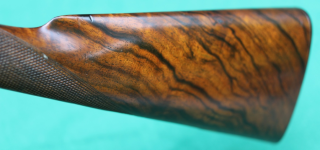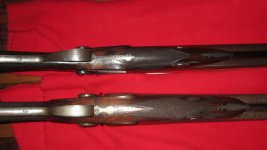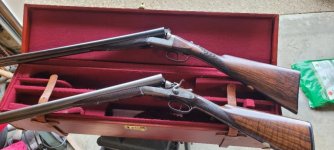Londonshooter hit on an interesting subject with his pineapple finials (well, interesting to me, at least), so I can spare a few minutes for some thoughts on the matter.
Fine British guns are heaping with symbolism, some subtle, some not so much. In the 16th and 17th centuries the pineapple was the greatest of status symbols, as only the very rich could dream of affording one. Pineapple motifs abounded in architecture, famously decorating such iconic buildings as London’s St Paul’s cathedral, and many of the great houses. What better way to denote exclusivity and social status than to have pineapple decorations on your flintlock and percussion fowling pieces and pistols?
The study of symbolism, or semiotics, is a recognized discipline. It has been applied to many areas of study, such as architecture and the decorative arts. Curiously, little has been written on symbolism in gunmaking, despite its rich potential-- harnessing the power of fire and explosion, and all that. It is certainly worth looking at a few examples.
It wasn’t before the large-scale production of sporting arms at the end of the 19th century and through the 20th century that the average person could afford to buy one, and afford a place to shoot one. Looking at the price of fine guns and the cost of driven shoots in Britain today, it is still the domain of the well-heeled, though clay sports have made the pastime more affordable to many. In North America shooting had its roots in putting meat on the table, and the profusion of utilitarian guns made gun ownership a more egalitarian affair. During much of the Victorian period in Britain though (1837-1901), sporting guns were expensive and exclusive, and the ‘best’ guns were reserved for the rich and powerful.
The Victorians were obsessed with the past, while revelling in what they saw as modernity and technology. The well-off had the benefit of a classical education, as their foundation for developing critical thinking, moral reasoning, and leadership qualities; to put it another way, everything Greek and Roman was cool. The Victorians were very much into symbology, applying this ‘language’ to jewellery, flowers and gardening, furniture, and other everyday objects. While most gun-making craftsmen would have lacked a classical education, they were nonetheless skilled in their craft, and part of the growing movement centred around science and manufacturing. It was smart marketing on their part to include classical decorative flourishes, deep in meaning, to guns aimed at the classically-educated. Such was already the case with jewellery, and therefore jewellers, adept at the tricky task of engraving curved metal surfaces, were drafted to shape and engrave classical motifs on guns. Whereas sculpting of wood and deep engraving was to be found on Continental guns, British guns tended to have subtle shaping of wood and shallower engraving so as to not detract from the flowing lines of the gun.
The go-to design on British guns was the acanthus leaf. Acanthus is a group of spiny flowering plants common in the Mediterranean basin, and the Greeks and the Romans greatly used the acanthus leaf motif in architectural decoration. According to Greek mythology, the nymph Acantha was transformed into an acanthus plant by Apollo as punishment for rejecting his unwanted amorous advances and viciously scratching his face. The flower symbolized new life and growth. Use of the acanthus leaf in decoration was continued in Byzantine architecture, Medieval sculpture and wood carving, decorations in illuminated manuscripts, in Renaissance works, and on through to the Victorian era where acanthus leaf patterns can be seen almost everywhere. It is not surprising that the acanthus leaf appeared on guns aimed at the Greek- and Roman-obsessed.

The Greeks also favoured the anthemion, a flat, radiating/repetitive floral ornament (though some argue this was derived from the ancient Egyptian lotus-leaf palmette). Combine acanthus and the anthemion, and you get the flowing scrolls one associates with British gun engraving.
Usually the only sculpting that appeared on British hammer guns were the hammers, and this was done quite subtly. A popular Victorian decorative motif was the dolphinfish (mahi-mahi, dorado), first named and described during the voyages of Sir Walter Raleigh in the 1580s, but also appearing in Greek art since at least 1600 BCE. The dolphinfish was a common pattern on hammer noses; why, I have no idea. Just remember that the descriptive term ‘dolphin hammers’ refers to dolphinfish, and not the marine mammal.
Another hammer motif was the Mute swan, a symbol of grace and fidelity, which had the advantage of incorporating the ‘cap guard’ of the percussion hammer as the bird’s beak. The cap guard was a hold-over feature from percussion gun hammers, meant to deflect flying bits of copper cap. British gunmaking has always included features from the past as a means of implying continuity of design, and many hammers on Edwardian guns and later modern ones still have this unnecessary feature.
So, Victorian sporting guns were awash with classical symbolism and meaningful flourishes, aimed at pleasing the eyes of rich patrons brought up on Greco-Roman imagery and the hidden language of symbols. Another reason to appreciate British sporting guns.


































































































